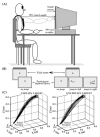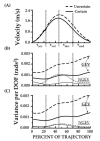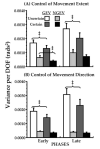Effect of motor planning on use of motor abundance
- PMID: 17331643
- PMCID: PMC1950341
- DOI: 10.1016/j.neulet.2007.02.037
Effect of motor planning on use of motor abundance
Abstract
This study examined the hypothesis that the degree to which motor redundancy is used to coordinate joint motions for reaching is influenced by motor planning and enhanced when the task requires greater movement flexibility. Subjects reached at arm's length to the same centrally placed target under conditions where the target location was either certain or uncertain, using a double-step paradigm. The hypothesis was evaluated by partitioning the across-trials variance of the joint configuration at each percent of the reach into a component corresponding to the use of different joint angle combinations to achieve an equivalent hand position (GEV) and a component leading to a variable hand position (NGEV). Pointer-tip movement variability along the path and variable targeting error did not differ between conditions. Larger overall joint variance was found for the uncertain target condition. Most of this increase was GEV, which was significantly higher in the uncertain condition for control of both movement extent and movement direction. In contrast, NGEV differed between the two conditions only for the control of movement extent early in the reach, suggesting that target uncertainty led to inter-trial timing variability along the movement path. The results suggest that more flexible patterns of joint coordination are used when the nervous system must plan reaching movements to an uncertain target direction.
Figures



References
-
- Bernstein N. The coordination and regulation of movements. Pergamon Press; 1967.
-
- Desmurget M, Prablanc C, Rossetti Y, Arzi M, Paulignan Y, Urquizar C, Mignot JC. Postural and Synergic Control for Three-Dimensional Movements of Reaching and Grasping. Journal of Neurophysiology. 1995;74:904–910. - PubMed
-
- Field A. Discovering Statistics using SPSS (Introducing Statistical Methods) 2. Sage Publications; 2005.
-
- Gordon J, Ghilardi MF, Ghez C. Accuracy of planar reaching movements. I. Independence of direction and extent variability. Exp Brain Res. 1994;99:97–111. - PubMed
-
- Grea H, Desmurget M, Prablanc C. Postural invariance in three-dimensional reaching and grasping movements. Exp Brain Res. 2000;134:155–62. - PubMed
Publication types
MeSH terms
Grants and funding
LinkOut - more resources
Full Text Sources

